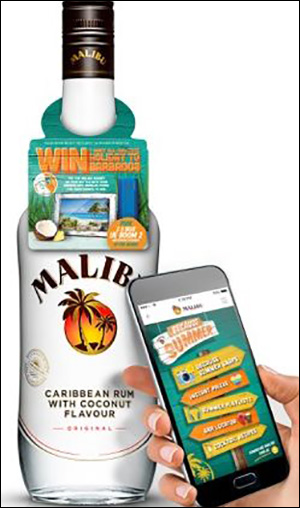Pernod Ricard UK is releasing “connected bottles” of Malibu, the company’s brand of coconut-flavored rum. The bottles are being fitted with Near Field Communication (NFC) RFID tags designed to enable consumers to access product-related content with the tap of an NFC-enabled phone. The technology being piloted (including NFC tags and content-management software) is provided by U.K. Internet of Things technology firm SharpEnd Agency.
The campaign, which began earlier this month, consists of 40,000 bottles, each with an NFC tag attached to its front, beneath Malibu’s sunset logo. The bottles are being sold at Tesco stores throughout the United Kingdom, with a “neckhanger” label inviting consumers to tap the front of the bottle to access a variety of offerings, including music, recipes and a contest.

In the long run, Malibu’s U.K. marketing managers hope not only to capture consumer interest, but also to better understand where bottles end up, as well as how much interest there is in the product, and where.
The Absolut Company (TAC), another of Pernod Ricard’s corporate divisions, has been collaborating with Malibu’s marketing managers on technology to further engage with U.K consumers. Absolute operates an innovation lab in Stockholm, where it and SharpEnd have developed the connected-bottles concept now being piloted.
TAC has been working with SharpEnd for the past few years to formulate a variety of advertising initiatives to use technology to drive consumer interest in its brands throughout the United Kingdom. “As an agency, we work across a number of brand owners, and are working on a wide range of projects utilizing RFID- and NFC-based solutions,” says Cameron Worth, SharpEnd’s founder. He calls his company the United Kingdom’s only dedicated Internet of Things agency that bridges the gap between marketing, technology and brand building.
Malibu’s marketers had hoped to pilot a system that would engage with consumers primarily, but also, in the future, enable the company to understand what happens to the product once it ends up with customers—the retailers that sell those goods. “Traditionally,” Worth explains, “when a bottle has gone to the retailer, Malibu—or any brand, for that matter—loses insight from that point on.” They don’t know who each buyer is, how and where the product is purchased, or how it is being enjoyed. “The connected bottle enables Malibu to gain huge insight into their end users and get a lot closer to them.” The RFID technology does this, he adds, by capturing information regarding what content users access and where those individuals are located.
“Malibu is a brand targeted at digital natives,” says Markus Wulff, TAC’s digital innovation and IoT head. This means consumers who are likely to use their smartphones or other devices to access data digitally. Therefore, Malibu sought to engage with these customers via their phones. “Serving personalized content with seamless technology improves the relationship consumers have with an otherwise passive product,” he explains, “and allows us to be more in tune with what sort of additional experiences they might be after.”
The system consists of five user “experiences,” including the opportunity to win Ultimate Ears‘ UE Boom speakers, enter competitions for a holiday in Barbados, and connect to Malibu playlists, with songs from such artists as Groove Amada, Marvin Humes and Clean Bandit. The tag can also direct a user to the closest bar serving Malibu rum, based on the geo-location of that person’s phone. Lastly, the system offers recipes in an option known as the “bartender in a bottle.”
No app is required; a user simply taps the phone against the bottle, and the phone’s NFC reader captures the ID number of the tag’s NXP Semiconductors NTAG 213 NFC 13.56 MHz chip. (Worth declines to name the make and model or provider of the tag itself.) The ID number directs the phone to a URL where users can then access the Malibu features via their phone’s web browser. Although Apple‘s iPhone does not support open NFC technology platforms, Worth notes that iPhone users could type in the URL prinked on the bottle’s neckhanger to access the same content.
The user can then respond to the prompts that interest him or her. Malibu, in the future, could analyze data indicating which features interest customers the most—such as cocktail recipes or music—as well as where and when the bottles’ NFC RFID tags are being read. This would enable the company to further refine its campaigns down the line, or to analyze distribution according to products’ popularity in certain areas.
“We set up the innovation lab in Stockholm in 2015 to identify, evaluate and prototype with IoT technologies,” Wulff states. The lab is focused around three main areas, he adds: connected products, smart spaces and smart packaging.
The RFID-tagged Malibu bottles pilot, Wulff says, was launched to evaluate consumers’ willingness to interact with that product, and to test which services were of most interest. The pilot is slated to conclude at the end of this year, after which the company plans to evaluate the results.
“We have seen interest from other markets to launch connected bottles,” Wulff says. “The evaluation of the current pilot will answer when it will happen.”

